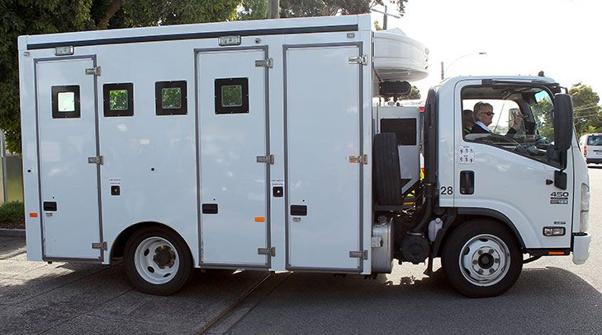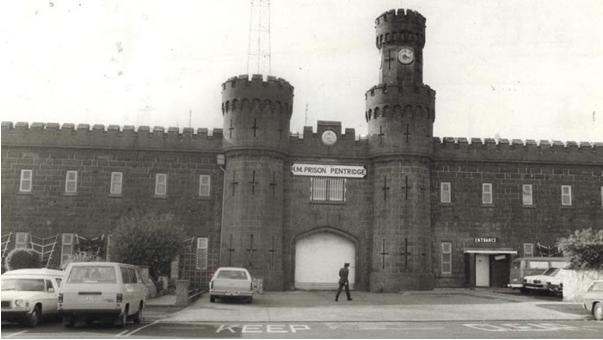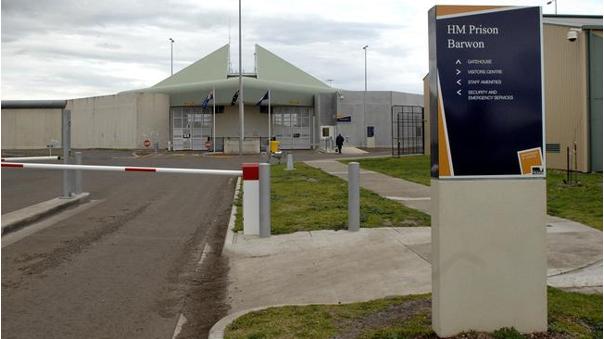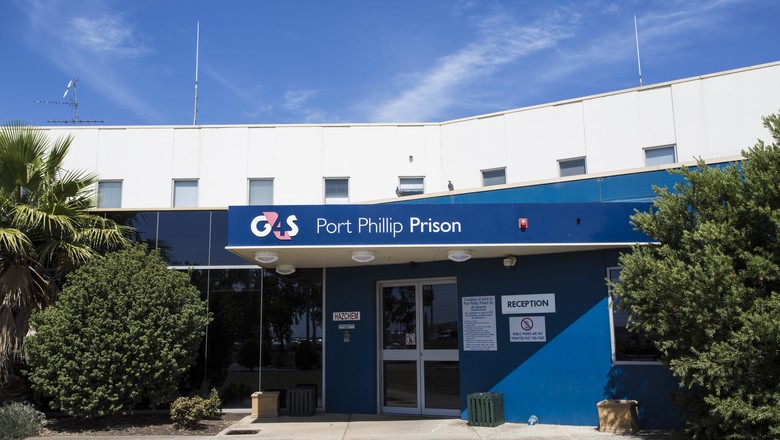Julian Knight surrendered to Victoria Police in North Fitzroy near to the Hoddle Street Shooting crime scene on the same night of 9th August 1987. It was within an hour of Knight commencing his shooting spree at random Hoddle Street traffic.
Knight was immediately arrested by police and transported under armed escort to Victoria Police’s St Kilda Road Police [Headquarters] Complex [at 412 St Kilda Road] and questioned by Homicide Squad detectives for around 14 hours. Knight was solemn, frank and fully co-operative with the questioning detectives as the initial police video on the night shows, as publicised by the television media at the time. [He was then in the early house of Sunday morning transferred to the old Melbourne City Watch House].

[In Julian Knight’s own words]:
“At this time Detective Senior Constable (now Superintendent) Graham Kent sent a memorandum (dated 10th August 1987) to the Officer-In-Charge of the [Melbourne] City Watch House and to the prison authorities, informing them that it was quite apparent that I was suicidal [he had packed a suicide round in his jeans pocket but had lost it during the shootings] and that, due to the nature of the offences that I had committed, it was highly likely that I would be at risk [of physical assault or murder] from other prisoners.”
Knight was still intoxicated at the time of his arrest by police and was immediately incarcerated. It would be the start of his minimum long prison term.
Following the police investigation into the shooting spree, and Knight’s confession and full co-operation with Victoria Police including him leading a walk-around re-enactment with police of his exact movements on the night, then ultimately the judicial process, Knight was sentenced by the Supreme Court of Victoria on 10th November 1988 to 27 year minimum imprisonment without being eligible for parole.
The court case of R v Knight [1988] was not a trial, but rather a formal legal court process comprising a series of hearings and concluding with his sentencing. This is because Julian Knight had immediately upon capture and arrest from the outset, fully and candidly co-operated with investigating police, confessed to the shootings and then pleaded guilty at the subsequent Plea Hearing.
From Knight’s handed-down sentence at the Supreme Court of Victoria over a year later on 10th November 1988, Julian Knight was immediately transferred to a remand holding cell in the then adjacent Melbourne City Watch-House via the underground prisoner tunnel. Then that same day he was then transported by secure police prisoner truck to the Victorian permanent prison system to serve out his prison time for a minimum non-parole 27 year sentence.
In H.M. Pentridge Prison, Coburg [1988-1994]
Upon arrival within minutes, prisoner Knight was moved to, received and processed to Pentridge’s notorious internal H-Division. H-Division was an internal fortress high security prison within the Pentridge Prison complex. It was used to house those deemed to be Victoria’s most troublesome, violent, and dangerous prisoners; so demanding high security, discipline, else protection (from the general prison population) which was deemed to be in Julian Knight’s case. The prison guards were well aware of the massacre he had committed so were not kind to him.
It was like Duntroon bastardisation all over again but much worse.

Knight spent three years in high security H Division: 1987-89 & 1993, after which he was transferred to Barwon Prison because the Victorian Government had decided to shut down H.M. Pentridge Prison permanently officially on 1st May 1997. The decision was motivated by the age of Pentridge (1851), its anachronistic treatment of prisoners and that the many controversies such as the Jika Jika escapes and deaths, privatization, riots, strikes and drug problems.
It was while he was in Pentridge Prison that Knight undertook tertiary studies by distance education studying a Bachelor of Arts degree course part-time and off-campus through Deakin University from 1988.
From his sentencing on 10th November 1988, Knight was immediately transferred to H.M. Pentridge Prison, situated 8 km north of the Melboure City Watch-House at 1 Champ Street in Melbourne’s working class suburb of Coburg. The police investigation and charge cases followed by the judicial hearing and sentencing process had taken 13 months. It was 13 months since his arrest on the night of 9th August 1987. That period would factor into being part of Knight’s overall incarceration term.
Knight was initially incarcerated in the prison’s notorious H-Division section. H-Division as an internal fortress high security prison within the Pentridge Prison complex. It was used to house those deemed to be Victoria’s most troublesome, violent, and dangerous prisoners; so demanding high security, discipline, else protection (from the general prison population) which was deemed to be in Julian Knight’s case.
H-Division design was modelled on that of the Old Melbourne Gaol. [Further reading about Pentridge Prison: https://en.wikipedia.org/wiki/HM_Prison_Pentridge]
Upon arrival at H.M. Pentridge Prison, Knight was ‘processed’ as a new intake, and the prison guards were well aware of the massacre he had committed so were not kind to him. It was like Duntroon all over again, a man that had become used to being institutionalised.
Upon arrival within minutes, prisoner Knight was moved to, received and processes to Pentridge’s notorious internal H-Division. H-Division was an internal fortress high security prison within the Pentridge Prison complex. It was used to house those deemed to be Victoria’s most troublesome, violent, and dangerous prisoners; so demanding high security, discipline, else protection (from the general prison population) which was deemed to be in Julian Knight’s case.
Knight spent three years in high security H Division: 1987-89 & 1993, after which he was transferred to Barwon Prison because the Victorian Government had decided to shut down H.M. Pentridge Prison permanently officially on 1st May 1997. The decision was motivated by the age of Pentridge (1851), its anachronistic treatment of prisoners and that the many controversies such as the Jika Jika escapes and deaths, privatization, riots, strikes and drug problems.
It was while he was in Pentridge Prison that Knight undertook tertiary studies by distance education studying a Bachelor of Arts degree course part-time and off-campus through Deakin University from 1988.
Knight on 10th September 1991 had applied for a AUSTUDY education allowance of $30 per week, but this was rejected by the Victorian Government’s Department of Employment, Education and Training (DEET) on the basis that he was ineligible by virtue that he was in lawful custody. On 14th July 1992, DEET’s Student Assistance Review Tribunal (‘SART’) then terminated his enrolment on the basis for non-payment of $96 fees and charges payable. So on 30th September 1991, Knight appealed to the Administrative Appeals Tribunal of Australia (AAT) to reverse that decision. A year later Knight’s case decided not in his favour on 7 September 1992.
Sinister Background to H.M. Pentridge Prison:
In H.M. Prison Barwon, Anakie [1994-2005]
Most prisoners held in Pentridge were relocated to H.M. Prison Barwon over a period of time between January 1990 and early 1997, following the decison to shut down H.M. Pentridge Prison permanently from 1st May 1997. H.M. Prison Barwon is a male only rural prison situated at 1140 Bacchus Marsh Rd, Anakie, about 10km north of Geelong in southern Victoria on flat desolate disused sheep country.

In 1994, Corrections Victoria transferred Julian Knight from H.M. Pentridge Prison to H.M. Barwon Prison.
At Barwon Prison, Knight continued his Bachelor of Arts studies, graduating in May 1996 with a Bachelor of Arts degree from Deakin University majoring in Strategic and Defence Studies. The subjeect matter would have been what he as an Army trainee officer staff cadet had expected to receive as military academic traning at the Royal Military College at Duntroon during his enrolment there in 1987-1988. It is likely that Deakin University’s tertiary course would have been superior to RMC’s and no-one falling asleep during lectures.
At H.M. Prison Barwon, Knight was initially assigned a ‘B’ (Banksia) medium security rating, designed as a management unit for prisoners requiring close supervision or protection. All cells in this unit being single cells (one prisoner per cell).
However, soon after Knight’s ‘placement’, his security rating was reviewed and then amended to place him in Acacia ‘A-2’, the second highest security unit designed for high-risk and dangerous prisoners on a temporary basis. In Knight’s case, the H.M. Prison Barwon management subsequently tried to justify that its initial placement of Knight to ‘B’ (Banksia) medium security rating had been “..an oversight in the computer data”.
Only one unit is rated higher security, being Acacia ‘A-1’, so designed to house the most dangerous prisoners on a permanently while they serve out their prison sentence. The Acacia High Security Unit has capacity to hold up to 24 prisoners in 4 separate areas, and is the oldest management unit within the prison.
Despite its more modern design, H.M. Barwon Prison (opened in 1990) has become notorious since the demise of Pentridge Prison for being Victoria’s toughest jail, for gang standover tactics, gang attacks, inmate bashings and murders. Everyone from drug lords, outlaw bikie gang members, Muslim gangs, Pacific islander gangs, racist White and Black gangs fight to survive, inmates are stabbed or can be bashed over the simplest of mistakes or perceived ‘ratting’.
Knight, following his harrowing experiences at Pentridge Prison, had learnt how to box and know of the needs to defend himself to survive attack from vicious inmates who may hold some grudge agains him.
On 22 October 2001, Knight appeared before the Supreme Court of Victoria in his first Supreme Court case against the prison authorities, seeking an injunction ordering the return of documents prepared for the inquest into the death of a prisoner who had hanged himself in 2000. The documents were returned in court that day and Knight’s application was dismissed by Supreme Court.
In 2002, a search of Knight’s Acacia A-2 cell claimed to have found ‘contraband’ detailed as follows:
- A collection of cards featuring slogans such as “Stop the Asian invasion”, “We just hate all queers”, “White power” and “Dial-a-racist” with contact details
- Political pamphlets, White Supremacist literature, war literature, sheets of paper with pictures of Adolf Hitler in uniform, and another with Nazi insignia.
- Blades, sharpened knives
- Medication bottles
- A leather belt
- Two television remote controls, an extension lead
- A can opener, bale hooks
- Stationery -permanent markers
- Computer disks – many containing information relating to prison security and staff, pornographic material, prison manuals, staff pictures, T.A.B. betting information, and prison and staff roster
- Sandpaper and masking tape.
On 4 July 2002, Knight appeared before the Victorian Civil and Administrative Tribunal (VCAT) with his complaint regarding an abuse of human rights where prison officers removed items “of a political nature” from his cell. Counsel for Correctional Services Robert Shepherd said the ‘contraband’ involved the possession of weapons, used to inflict violence. Knight’s application was dismissed, even though many of the seized items were returned to him by the prison management.
Then Barwon Prison management decided in December 2002 to relegate Knight as a to be housed in Acacia A-1 (permanent highest security) as punishment Knight’s contraband offences. Knight’s was relegated on a long-term regime of virtual solitary confinement, locked in a small, bare cell for 22 hours a day. At most, he mixed with one other prisoner for two hours in an exercise cage.
In May 2003, six months later, Knight asked the prison authorities when he would be moved to a unit consistent with his lower A-2 security rating. In response, he was told his placement outside Acacia unit would be reviewed in January 2004.
Knight considered this to be unjust. In 1998, a similar regime was described by the Supreme Court of South Australia as “oppressive”, “extremely claustrophobic” and “counter-productive to rehabilitation”.
So sought a judicial review over his Acacia A-1 high security detention. Knight’s case was not unmeritorious or vexatious. It concerned fundamental issues relating to prisoner welfare and rehabilitation and the use by prison authorities of one of the most extreme powers granted to them – the power to keep a prisoner in 22-hour-a-day solitary confinement. This is why the Brimbank Community Legal Centre took on Knight’s case.
Knight’s legal counsel argued in Supreme Court of Victoria before Justice Cummins that his stay in a maximum security unit at Victoria’s Barwon prison was “unjustified”. Knight argued his detention, which is subject to a monthly review, was “open-ended”. He said a fellow prisoner has been in high security for more than decade.
Justice Marilyn Warren dismissed an application by the prison authorities to strike out Knight’s case as “unmeritoriuous” and “vexatious”. Politically, the Victorian Attorney-General sided with Corrections Victoria trying to have Knight declared a vexatious litigant.
However, in February 2004 the Supreme Court refused an application by the prison authorities to have Knight’s case summarily dismissed on the basis that the claim was frivolous, vexatious, an abuse of process or bad in law.
The Brimbank Community Legal Centre reported that Knight’s legal application was the proper process for the determination of these issues:
“The process should not be some politically expedient scheme designed to silence prisoners from bringing legitimate grievances before our courts. Hulls’s reported action in this regard is both unfortunate and inappropriate, given Knight’s pending appeal in this matter. The free and unfettered access of prisoners to the courts is vital to the protection of the basic human rights of one of the most vulnerable groups in our society. No government should move to restrict that access.”
On 7 October 2003, Knight appeared before the Supreme Court of Victoria seeking injunctions in regards to opening of private legal mail, prison disciplinary hearings, conditions in solitary confinement cells and Knight’s security classification and imprisonment in Barwon Prison’s high security Acacia wing. Supreme Court Judge Justice Philip Cummins said of Knight’s application: “I consider that ordinary tax-payers should not be fixed with the burden of these proceedings. Accordingly, in each instance I order that the costs of the proceedings of the respective defendants be paid by the plaintiff.” The application was dismissed.
Illness:
[In Julian Knight’s own words]:
“In March 1995, I contracted Crohn’s disease, a chronic and incurable inflammation of the digestive tract. During 1995-2010, I suffered from various acute periods of the disease flaring up. My condition was not stabilized until March 2010. If I had been still serving [in The Army] in March 1995, I would probably have been relegated to the Reserve List of Officers or been transferred to the Active Army Reserve.”
In Port Phillip Prison, Truganina [2005-current]

Originally called Port Phillip Correctional Centre, Port Phillip Prison is a maximum security prison located at Truganina on the western outskirts of Melbourne. It received its first prisoners on 10th September 1997 and is able to accommodate up to 1117 prisoners. It is privately operated on behalf of the Government of Victoria by G4S Australia Pty Ltd.
Julian Knight was transferred from Barwon Prison to Port Phillip Prison in 2005, where he has remained to date.

In 2010, Knight transferred to the Bachelor of Criminology and Criminal Justice degree course part-time and off-campus via Griffith University. He would use the knowledge of the law to challenge the prison authorities for his ongoing poor treatment in prison and denial of his human rights.
[In Julian Knight’s own words]:
Fitness:
In spite of imprisonment and my medical condition, I have managed to otherwise maintain a high level of fitness.
In September 2005 (age 37), I attained a score of 13.4 on the 20m “Beep Test” (Multi-Stage Fitness Test -“Beep” Test -20m Shuttle Run Test).
In March 2006 (age 38) , I completed a 5 km run in 24:08 minutes. In August 2012 (age 44) , I attained a score of 12.1 on the 20m “Beep Test”, and I completed a 5 km run in 23:15 minutes.
In February 2013 (age 44), my body weight was recorded as 69.4kg (compared to 69kg at the time of my discharge from RMC in July 1987), and my Body Fat Content was 7.5%.”
References:
[1] ‘Even Julian Knight is entitled to basic human rights‘, 25th November 2003, The Age newspaper, https://www.theage.com.au/national/even-julian-knight-is-entitled-to-basic-human-rights-20031125-gdwt06.html
